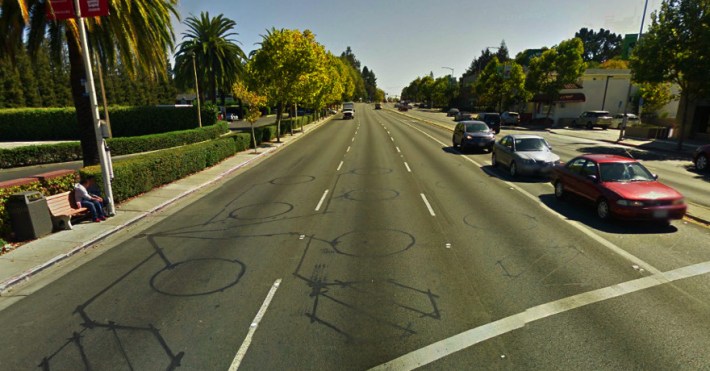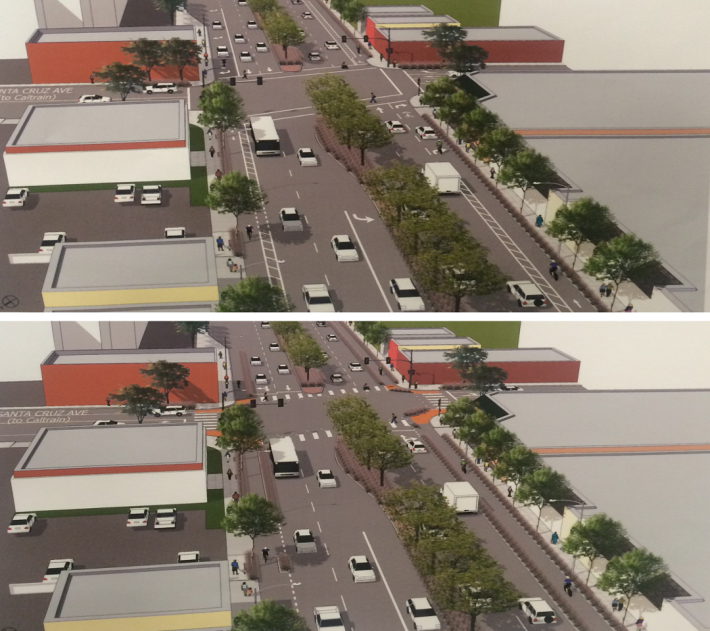
Redesigning El Camino Real to squeeze in more cars will cause more cars to squeeze into El Camino Real, warned the consultant working on a redesign of the street in downtown Menlo Park last week. But creating a safe street for people to get around without a car can actually cut traffic.
At a community meeting last Thursday about the design options for Menlo Park's stretch of El Camino Real W-Trans Principal Mark Spencer said that widening the street from four to six traffic lanes through downtown would increase traffic volumes dramatically and worsen congestion. Adding buffered or curb-protected bike lanes instead, as recommended by the city’s Transportation Commission in November, would reduce both traffic volumes and congestion slightly, according to the study.
With the six lane option, "traffic volumes on El Camino would go up because it would open up that pipeline to push more traffic through," Spencer said. "Because of that induced demand, we’re seeing travel times [for car drivers] getting longer."
A 2008 community-led Vision Plan for El Camino Real in Menlo Park set several goals that street safety advocates say should disqualify the four-to-six lane expansion from consideration. Among those objectives are “maintain a village character,” “provide greater east-west, town-wide connectivity,” and "provide an integrated, safe, and well-designed pedestrian and bicycle network."
To help meet these community goals, planners recommended maintaining the existing four-lane cross-section for vehicle traffic while adding buffered or protected bike lanes. But with the adoption of the El Camino Real / Downtown Specific Plan in 2012, the City Council also ordered that a six-lane expansion of El Camino be analyzed as well, in the belief that the city might be able to build its way out of congestion.
W-Trans estimates that due to induced demand, widening El Camino Real to a continuous six lanes through downtown Menlo Park would add between 10 and 45 percent more traffic at Ravenswood Avenue, the city’s most congestion intersection. Most of that traffic would be pulled from parallel routes, including Highway 101 and Middlefield Road.
“This option worsens the pedestrian environment as it places fast moving traffic near pedestrians,” wrote Fehr & Peers Principal Jane Bierstedt in a March 2012 report [PDF]. Even without the effect of induced demand, which its preliminary traffic study did not account for, Fehr & Peers found that the maximum travel time savings for car drivers would be 17 seconds at Ravenswood Avenue.
“With induced demand, the delay reduction would be less and operations would likely mimic the four-lane alternative,” concluded Bierstedt.

W-Trans also studied the impact of adding buffered bike lanes and curb-protected bike lanes. All three options, including the four-to-six lane expansion, would remove all of the parallel parking along the street in Menlo Park. Wider sidewalks, curb extensions, and pedestrian refuges could be included in the designs with bike lanes, but not in the six-lane design.
Buffered bike lanes, which would consist of "paint-only" and come in as the cheapest option, would give way to sharrows approaching intersections as well as along one entire block in the proposed design. Curb-protected bike lanes would include a Dutch-style protected intersection at El Camino Real and Santa Cruz Avenue.
W-Trans estimates that bicycle traffic would nearly quadruple on El Camino Real with the buffered bike lanes, and would increase by a factor of six with curb-separated bike lanes.
“If you improve the facility, you would expect there to be more pedestrians, more bicyclists,” said Spencer. “Look at the facility the way it is now. It’s not attractive and that’s hindering people who want to use it.”
W-Trans also announced a second online survey to determine the public's preferred design. Of the respondents to the first survey, taken last summer, 72 percent said they'd prefer to see bicycle lanes included on the street, and 56 percent agreed that parallel parking should be eliminated to make room for them.
On the table for each option is the addition of a third through lane to southbound El Camino Real at Ravenswood Avenue, a $1.5 million project to expand the street for traffic that would wipe out 11 heritage trees, including 10 redwoods. Street safety advocates are warning against adding the traffic lane, arguing that the quality of the pedestrian environment so close to the Caltrain station is critical, and would be worsened with an even longer crossing distance of El Camino.
The second online survey is scheduled to remain open until March 13. Further review by the city's commissions and City Council has not yet been scheduled.




